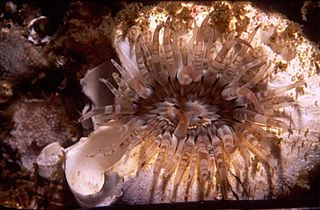
Actinia fragacea, commonly known as the strawberry anemone, is a species of sea anemone of the order Actiniaria, that occurs from Norway to Africa, including adjacent islands and the Mediterranean. It is generally found on rocks of the lower shoreline and depths up to 8–10 metres (26–33 ft).

Sea anemones are a group of predatory marine invertebrates constituting the order Actiniaria. Because of their colourful appearance, they are named after the Anemone, a terrestrial flowering plant. Sea anemones are classified in the phylum Cnidaria, class Anthozoa, subclass Hexacorallia. As cnidarians, sea anemones are related to corals, jellyfish, tube-dwelling anemones, and Hydra. Unlike jellyfish, sea anemones do not have a medusa stage in their life cycle.

Corynactis annulata, or the strawberry anemone, is a bright pink colonial anthozoan similar in body form to sea anemones and scleractinian stony corals. This species is a solitary animal of the order Corallimorpharia.
The brooding anemone, Halianthella annularis, is a species of sea anemone in the family Halcampidae,.

Anthothoe chilensis, or striped anemone, is a species of sea anemones in the family Sagartiidae.

Anthostella stephensoni, the violet-spotted anemone, is a species of sea anemone in the family Actiniidae.

Pseudactinia flagellifera, the false plum anemone, is a species of sea anemone in the family Actiniidae. It is also a member of the kingdom, Animalia.

Anthopleura michaelseni, commonly known as the long-tentacled anemone or crevice anemone, is a species of sea anemone in the family Actiniidae. It is native to very shallow water round the coasts of southern Africa between Lüderitz and Durban.

Korsaranthus natalensis, commonly known as the spinnaker anemone or the candy-striped anemone, is a species of sea anemone in the family Actiniidae. It is the only member of its genus.

The sandy anemone is a species of sea anemone in the family Actiniidae. It is native to very shallow water round the coasts of southern Africa between Luderitz and Durban.

The walking anemone, also known as the hedgehog anemone or sock anemone, is a species of sea anemones in the order Actiniaria. It is the only member of its genus, Preactis.

The multicoloured sea fan is a species of gorgonian sea fan in the family Melithaeidae.

The ring-tentacle anemone is a species of sea anemone in the family Isanthidae.

The Cape zoanthid is a species of zoanthid in the family Parazoanthidae.

Balanophyllia bonaespei is a species of solitary cup coral, a stony coral in the family Dendrophylliidae. It is an azooxanthellate species that does not contain symbiotic dinoflagellates in its tissues as most corals do.

Diadumene cincta is a small and delicate, usually orange, sea anemone. It has a smooth slender column and up to 200 long tentacles, and normally grows to a length of up to 35 mm (1.4 in), with a base of 10 mm (0.4 in), but specimens twice this size have been recorded. Diadumene cincta is found in the northeastern Atlantic Ocean.

Diadumene leucolena, commonly known as the white anemone or ghost anemone, is a species of sea anemone in the family Diadumenidae. It is an inconspicuous species found in the intertidal and subtidal areas of the northeastern Atlantic Ocean, the Caribbean Sea and the northern Pacific Ocean. Diadumene, "diadem-bearer", referring to the crown of tentacles, is a female form intended to bring to mind the Diadumenos, the renowned Greek sculpture of an athlete crowning himself with the victor's ribbon diadem.

Haloclava producta is a species of sea anemone in the family Haloclavidae, commonly known as the ghost anemone. This species is native to shallow water in the northwestern Atlantic Ocean, between Cape Hatteras and the Bay of Fundy, where it makes a temporary burrow in soft sediment. It is found on sand flats, both intertidally and subtidally.

Corynactis viridis, the jewel anemone, is a brightly coloured anthozoan similar in body form to a sea anemone or a scleractinian coral polyp, but in the order Corallimorpharia. It is found in the northeastern Atlantic Ocean and the Mediterranean Sea and was first described by the Irish naturalist George Allman in 1846.

Bunodosoma cavernatum, commonly known as the warty sea anemone or the American warty anemone, is a species of sea anemone in the family Actiniidae. It occurs in the tropical and subtropical western Atlantic Ocean and the Caribbean Sea. It was first described in 1802 by the French naturalist Louis Augustin Guillaume Bosc, one of fourteen marine invertebrates described and named by him.



















